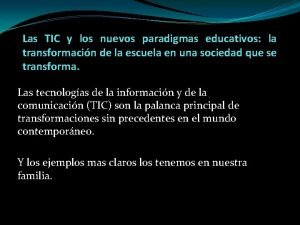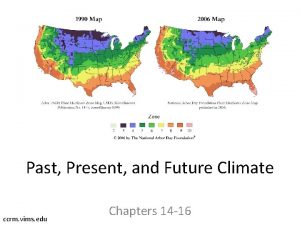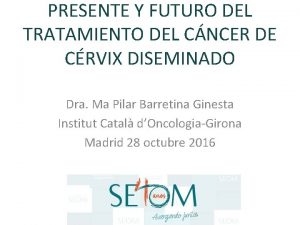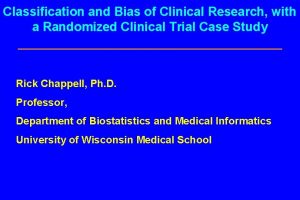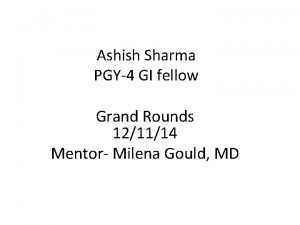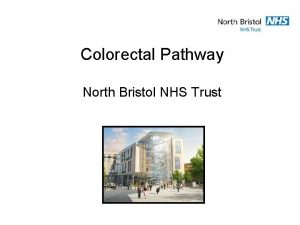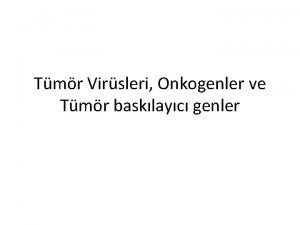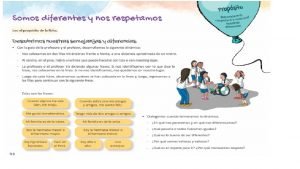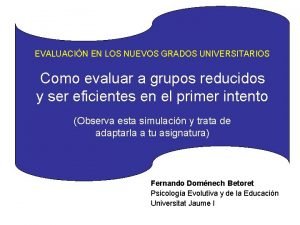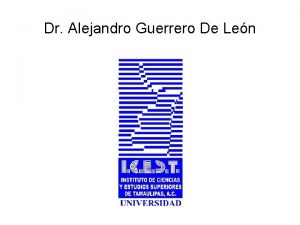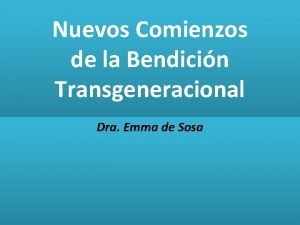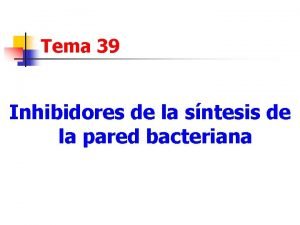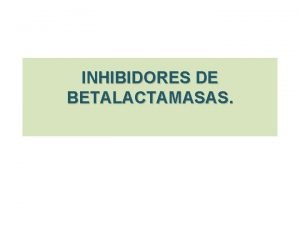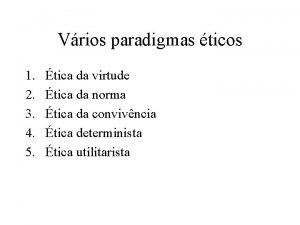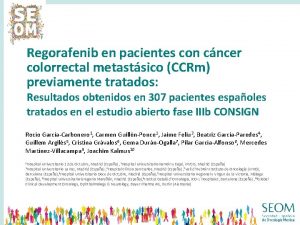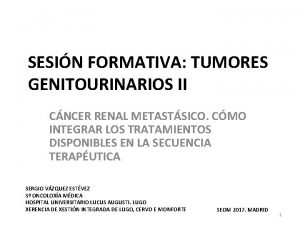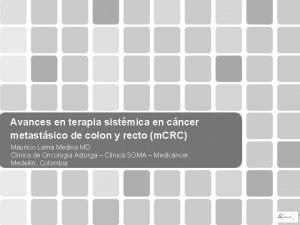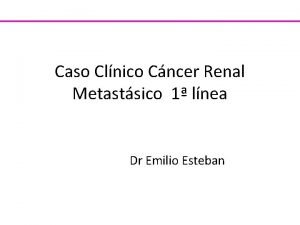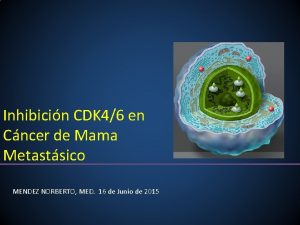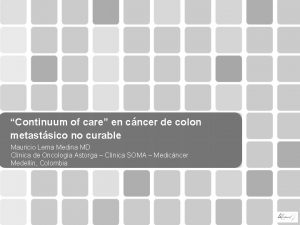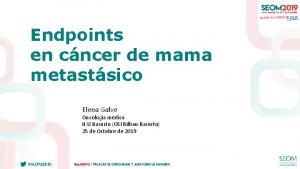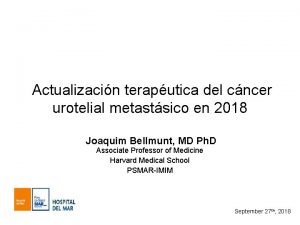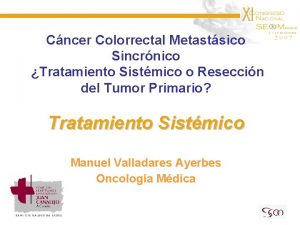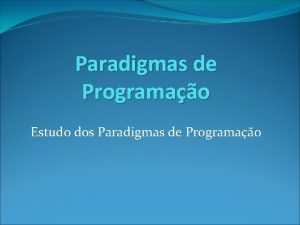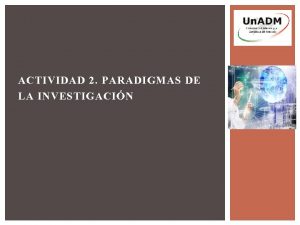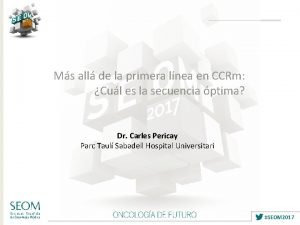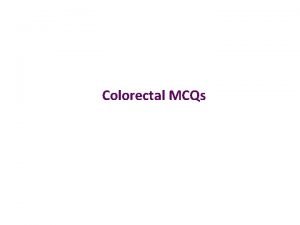Nuevos paradigmas en cncer colorectal metastsico CCRm Nos









































- Slides: 41

Nuevos paradigmas en cáncer colorectal metastásico (CCRm): ¿Nos estamos acercando a la cura? Juan M OConnor Instituto A Fleming 1506 LA 2004015 -01

AGENDA 1 - CCR ACTUALMENTE 2 - RACIONAL 3 - EVIDENCIA CLINICA

Multi. OMICS en CRC Dienstmann R, et al. Nat Rev Cancer. 2017; 17(2): 79 -92.

Rol de Inhibidores de CHP (5% MSI)

AGENDA 1 - CCR ACTUALMENTE 2 - RACIONAL 3 - EVIDENCIA CLINICA

Alteraciones funcionales en la replicación del ADN y mutaciones Errores generados durante la replicacion del ADN 1 Genes claves en la via de reparación 2: Approved symbol MLH 1 MSH 2 PMS 2 MSH 6 Proficient mismatch repair (p. MMR): Eficiencia de los genes reparadores del ADN Deficient mismatch repair (d. MMR): Deficit en los genes reparadores del ADN Errores no detectados y acumulados Deficiente reparación de errores Approved name EXO 1 exonuclease 1 HMGB 1 high mobility group box 1 LIG 1 DNA ligase 1 MLH 1 mut. L homolog 1 MLH 3 mut. L homolog 3 MSH 2 mut. S homolog 2 MSH 3 mut. S homolog 3 MSH 6 mut. S homolog 6 PCNA proliferating cell nuclear antigen PMS 1 homolog 1, mismatch repair system component PMS 2 PMS 1 homolog 2, mismatch repair system component POLd DNA polymerase delta RFC replication facto C RPA replication protein A Genes involucrados en la vía de d. MMR DNA, deoxyribonucleic acid; LOH, loss of heterozygosity; MMR, mismatch repair; PMS, post-meiotic segregation. 1. Lee V et al. Oncologist. 2016; 21(10): 1200 -1211. 2. Jalal S et al. Clin Cancer Res. 2011; 17(22): 6973 -6984.

d. MMR/MSI-H § ~15% de CRCs tempranos d. MMR/MSI-H 1 § ~4– 5% de CRCs metastásicos d. MMR/MSI-H 1 d. MMR/MSI-H in CRC d. MMR/MSI-H en CRC hereditario (Síndrome de Lynch ) 2 d. MMR/MSI-H en CRC esporádico 2 • 10– 15% de cancer de colon esporádicos • Raro en cancer rectal • Mutación BRAF (V 600 E) asociada • 3% de todos los CRCs 1 • Mutación de genes 2: • MLH 1 (42%) • MSH 6 (18%) • PMS 2 (7%) • MSH 2 (33%) • Sme Lynch asociado con alto riesgo CRC 2 CRC=colorectal cancer; d. MMR=deficient mismatch repair; MSI-H=microsatellite instability high; MLH 1=mut. L homolog 1; MSH 2=mut. S protein homolog 2 1. Sinicrope FA, Sargent DJ. Clin Cancer Res. 2012; 18(6): 1506 -12. 2. Richman SD. Int J Oncol. 2015; 47(4): 1189 -1202.


Metodos: IHC vs PCR 1, 2 • • • IHC y PCR tienen la misma especificidad y sensibilidad para detectar MSI tumoral Ambos tienen un 5%– 10% de falsos negativos Heterogeneidad en el Mercado de cómo se combinan MMR MSI Inestabilidad microsatelital 1, 3, 4 1, 2, 5 Genes reparadores del ADN Metodo • IHC • PCR Hallazgo • Presencia o ausencia de proteinas de reparación • Presencia o ausencia de mutaciones del ADN Ventajas • • • Bajo costo Baja tecnología Rápido resultado • • Test único Kit disponible (Promega) • Depende de la interpretación del patólogo (tinción/interpretación) Muchos anticuerpos disponibles para cada proteína • • • Más caro Tarda más el resultado Requiere un tejido de control normal (tejido o sangre) Desventajas • d. MMR, deficient mismatch repair; DNA, deoxyribonucleic acid; MSI-H, high microsatellite instability. 1. Richman R. Int J Oncol. 2015; 47: 1189 -1202. 2. Van Cutsem E. Ann Oncol. 2016; 27: 1386 -1422. 3. Promega. Accessed December 14, 2016. 4. Quest Diagnostic. Accessed December 14, 2016. 5. ARUP. Accessed December 14, 2016.


¿Cuál es el racional para el uso de I-CHP?

AGENDA 1 - CCR ACTUALMENTE 2 - RACIONAL 3 - EVIDENCIA CLINICA

A-Z Immuno-Oncology in MSI-H/d. MMR Cancers Check. Mate 142 Study Design – MSI-H Cohorts Check. Mate 142: Study Design Combination (safety cohort)1, 2 Monotherapy (NIVO)1, 3 Combination (NIVO+IPI)1, 4 Cohort C 31, 5 Cohort C 41 Cohort C 51, 6 Cohort C 61 Nivolumab + Ipilimumab Nivolumab + Ipilimumab + Cobimetinib Nivolumab + Relatlimab Nivolumab + Daratumumab 3 L+ Non–MSI-H m. CRC 2 L+ MSI-H m. CRC 1 L MSI-H m. CRC Non–MSI-H Cohort 1. Clinicaltrials. gov. NCT 02060188. Accessed February 10, 2020; 2. Overman M, et al. J Clin Oncol 2016; 34(suppl): Abstract 3501; 3. Overman M, et al. Lancet Oncol 2017; 18: 1182– 1191; 4. Overman M, et al. J Clin Oncol 2018; 36: 773– 779; 5. Lenz H-J, et al. ESMO 2018 oral presentation, presentation number LBA 18_PR; 6. National Cancer Institute. NCI Drug Dictionary. https: //www. cancer. gov/publications/dictionaries/cancer-drug/def/anti-lag-3 -monoclonal-antibody-bms-986016. Accessed 28 November 2019. Local approval may be required before external use. Refer to local guidelines. Rationale for Immunotherapy in MSI-H Tumors Ongoing Nivolumab Trials: m. CRC and Pan-Tumor Nivolumab Monotherapy for MSI-H m. CRC Nivolumab + Ipilimumab Combination Therapy for MSI-H m. CRC Ongoing I-O Competitor Trials 13

A-Z Immuno-Oncology in MSI-H/d. MMR Cancers Check. Mate 142 Monotherapy Cohort Study Design 1, 2 • Histologically confirmed metastatic or recurrent CRC Monotherapy cohorta • MSI-H/d. MMR per local laboratory Primary endpoint: • ORR per investigator assessment Nivolumab 3 mg/kg Q 2 W • ≥ 1 prior line of therapy Other key endpoints: • ORR per BICR, DCR, b DOR, PFS, OS, and safety Primary analysis (N = 74): efficacy per BICR and safety; median follow-up, 12 months (0. 3– 31. 7), c 13. 4 months (range, 10– 32), d and 21 months (range, 17– 40) d Subset analysis 1: • Group A (n = 53): received ≥ 3 prior chemotherapies, including a fluoropyrimidine, oxaliplatin, and irinotecan • Group B (n = 21): did not receive prior treatment with all 3 of these chemotherapies (fluoropyrimidine, oxaliplatin, and irinotecan) a. Enrollment was staggered with additional patients being enrolled if ≥ 7 of the first 19 centrally confirmed MSI-H patients had a confirmed response (CR or PR). b Patients with a CR, PR, or SD for ≥ 12 weeks. c. Time between first dose date and last known date alive. d. Time from first dose to database cutoff. 1. Overman MJ, et al. Oral presentation at ASCO-GI 2018; 2. Overman MJ, et al. Lancet Oncol. 2017; 18(9): 1182– 1191. Local approval may be required before external use. Refer to local guidelines. Rationale for Immunotherapy in MSI-H Tumors Ongoing Nivolumab Trials: m. CRC and Pan-Tumor Nivolumab Monotherapy for MSI-H m. CRC Nivolumab + Ipilimumab Combination Therapy for MSI-H m. CRC Ongoing I-O Competitor Trials 14

A-Z Immuno-Oncology in MSI-H/d. MMR Cancers Best Reduction in Target Lesion: All Patients Best reduction from baseline in target lesion size (%)a 100 80 • 60% of patients had a reduction in tumor burden from baseline with nivolumab monotherapy 60 40 20 20 † 0 -20 -30 -40 -60 -80 -100 *Confirmed response per BICR assessment; % Change truncated to 100%. † Patient from Group A with 0% best reduction in target lesion Group A: patients received ≥ 3 prior chemotherapies including a fluoropyrimidine, oxaliplatin, and irinotecan Group B: patients did not receive prior treatment with all 3 of these chemotherapies (fluoropyrimidine, oxaliplatin and irinotecan) a. BICR data with a median follow-up of 21 months (range, 17 -40). Overman MJ, et al. Oral presentation at ASCO-GI 2018. Local approval may be required before external use. Refer to local guidelines. Rationale for Immunotherapy in MSI-H Tumors Ongoing Nivolumab Trials: m. CRC and Pan-Tumor Nivolumab Monotherapy for MSI-H m. CRC Nivolumab + Ipilimumab Combination Therapy for MSI-H m. CRC Ongoing I-O Competitor Trials 15

A-Z Immuno-Oncology in MSI-H/d. MMR Cancers Deepening of Response With Longer Follow-Up 1 All patients N = 74 a ORR, n (%) [95% CI] 13 -Month follow-upb, 2 21 -Month follow-upb 24 (32) [22. 0, 44. 3] 25 (34) [23. 2, 45. 7] Best overall response, n (%) CR PR SD PD Not determined 2 (3) 7 (9) 22 (30) 18 (24) 25 (34) 23 (31) 21 (28) 22 (30) 4 (5) Disease control, n (%)c 47 (64) 46 (62) • CR rates increased in all patients with longer follow-up • Similar trends in CR were observed in groups A and Bd a. BICR data; b. Defined here as the time from first dose to data cutoff; c. Patients with a CR, PR, or SD for ≥ 12 weeks; d. Group A patients received ≥ 3 prior chemotherapies, including a fluoropyrimidine, oxaliplatin, and irinotecan. Group B patients did not receive treatment with all 3 of these chemotherapies (fluoropyrimidine, oxaliplatin, and irinotecan). 1. Overman MJ, et al. Oral presentation at ASCO-GI 2018; 2. Overman MJ, et al. Lancet Oncol 2017; 18: 1182– 1191. Local approval may be required before external use. Refer to local guidelines. Rationale for Immunotherapy in MSI-H Tumors Ongoing Nivolumab Trials: m. CRC and Pan-Tumor Nivolumab Monotherapy for MSI-H m. CRC Nivolumab + Ipilimumab Combination Therapy for MSI-H m. CRC Ongoing I-O Competitor Trials 16

¿Existe Resistencia secundaria en los respondedores? Keynote - 158 Resistencia primaria 46% 3 ra línea Checkmate -142 Resistencia primaria 28% 20% Resistencia secundaria Cortesia Dr Dan Aderka

¿Cuál es la evidencia actual para Nivo/Ipilimumab?

A-Z Immuno-Oncology in MSI-H/d. MMR Cancers Check. Mate 142 Study Design (nivolumab + low-dose ipilimumab; 2 L+) 1– 4 Phase 2 Nonrandomized Study • Histologically confirmed metastatic or recurrent CRC • MSI-H/d. MMR per local laboratory Combination cohorta Nivolumab 3 mg/kg + low-dose ipilimumab 1 mg/kg Q 3 W (4 doses and then nivolumab 3 mg/kg Q 2 W) Monotherapy cohorta • ≥ 1 prior line of therapy Nivolumab 3 mg/kg Q 2 W Primary endpoint: • ORR per investigator assessment (RECIST v 1. 1) Other key endpoints: • ORR per BICR, DCR, b DOR, PFS, OS, and safety • Results of the monotherapy cohort (N = 74) with a median follow-up of 13. 4 months (range, 10– 32) are presented 1, 2, c • Results from the combination cohort (N = 119), after median follow-up of 13. 4 months (range, 9– 25) and 25. 4 months (range, 21. 4– 37. 2) are presented 3, 4, c a. Enrollment was staggered with additional patients being enrolled if ≥ 7 of the first 19 centrally confirmed MSI-H patients had a confirmed response (CR or PR). Check. Mate 142 monotherapy and combination therapy cohorts were not randomized or designed for a formal comparison; b. Patients with a CR, PR, or SD for ≥ 12 weeks; c. Defined here as the time from first dose to data cutoff. 1. André T, et al. Oral presentation at ASCO-GI 2018. 2. Overman MJ, et al. Lancet Oncol 2017; 18: 1182– 1191; 3. Overman MJ, et al. J Clin Oncol 2018; 8: 773– 779. 4. Overman MJ, et al. Poster presentation at ASCO-GI 2019. Local approval may be required before external use. Refer to local guidelines. Rationale for Immunotherapy in MSI-H Tumors Ongoing Nivolumab Trials: m. CRC and Pan-Tumor Nivolumab Monotherapy for MSI-H m. CRC Nivolumab + Ipilimumab Combination Therapy for MSI-H m. CRC Ongoing I-O Competitor Trials 19

A-Z Immuno-Oncology in MSI-H/d. MMR Cancers Baseline Demographics and Disease Characteristics (nivolumab + low-dose ipilimumab; 2 L+) Nivolumab + low-dose ipilimumab N = 119 Median age (range), years 58. 0 (21– 88) Male, n (%) 70 (59) ECOG performance status, n (%) 0 1 54 (45) 65 (55) Disease stage at diagnosis, n (%) a I–III IV Tumor PD-L 1 expression at baseline, n (%) ≥ 1% < 1% Unknown 66 (55) 53 (45) 27 (23) 75 (63) 17 (14) Nivolumab + low-dose ipilimumab N = 119 Mutation status, n (%) BRAF/KRAS wild type BRAF mutation KRAS mutation Unknown Clinical history of Lynch syndrome, n (%)b Yes No Unknown Prior lines of therapy, n (%)c 1 2 3 ≥ 4 31 (26) 30 (25) 44 (37) 14 (12) 35 (29) 31 (26) 53 (45) 27 (23) 43 (36) 29 (24) 19 (16) • Median follow-up was 25. 4 months (range, 21. 4– 37. 2) Percentages may not add up to 100% because of rounding. a. All patients had stage IV disease at study entry; b. Based on the clinical records of the patients at sites in countries where this reporting was c permitted (excluded Italy); One patient had received no prior lines of therapy. Overman MJ, et al. Poster presentation ASCO-GI 2019. Local approval may be required before external use. Refer to local guidelines. Rationale for Immunotherapy in MSI-H Tumors Ongoing Nivolumab Trials: m. CRC and Pan-Tumor Nivolumab Monotherapy for MSI-H m. CRC Nivolumab + Ipilimumab Combination Therapy for MSI-H m. CRC Ongoing I-O Competitor Trials 20

A-Z Immuno-Oncology in MSI-H/d. MMR Cancers Investigator-Assessed Response and Disease Control (nivolumab + low-dose ipilimumab; 2 L+) 1, 2, 3 Median FU 13. 4 months 1, 2 Investigator assessment (N = 119) Median FU 13. 4 months 1, 2 BICR assessment (N = 119) Median FU 25. 4 months 3 Investigator assessment (N = 119) ORR, n (%) 65 (55) [95% CI] [45– 64] 58 (49) [40– 58] 69 (58) [49– 67] 4 (3) 5 (4) 7 (6) Partial response 61 (51) 53 (45) 62 (52) Stable disease 37 (31) 39 (33) 33 (28) 14 (12) 17 (14) 14 (12) 3 (3) 4 (3) 3 (3) 0 1 (1) 0 Disease control for ≥ 12 weeks, a n (%) 95 (80) [95% CI] [72– 87] 94 (79) [71– 86] 96 (81) [72– 87] Complete response Progressive disease Not determined Not reported • July 11, 2018: Nivolumab plus low-dose ipilimumab received accelerated approval from the US FDA for adult and pediatric (12 years and older) patients with MSI-H/d. MMR m. CRC that progressed following treatment with a fluoropyrimidine, oxaliplatin, and irinotecan, 4 based on overall response rate and duration of response from a median follow-up of 13. 4 months 1 a. Disease control was defined as patients with a CR, PR, or SD for ≥ 12 weeks. 1. Overman MJ, et al. J Clin Oncol 2018; 8: 773– 779; 2. André T, et al. Oral presentation at ASCO-GI 2018; 3. Overman MJ, et al. Poster presentation at ASCO-GI 2019; 4. OPDIVO® [prescribing information]. July 2018. Local approval may be required before external use. Refer to local guidelines. Rationale for Immunotherapy in MSI-H Tumors Ongoing Nivolumab Trials: m. CRC and Pan-Tumor Nivolumab Monotherapy for MSI-H m. CRC Nivolumab + Ipilimumab Combination Therapy for MSI-H m. CRC Ongoing I-O Competitor Trials 21

A-Z Immuno-Oncology in MSI-H/d. MMR Cancers Patient Disposition and Exposure (nivolumab + low-dose ipilimumab; 2 L+) Nivolumab + low-dose ipilimumab N = 119 Median number of doses (range) Nivolumab Ipilimumab 45 (1– 80) 4 (1– 4) Median duration of therapy, months (95% CI) 24. 9 (15. 8–NE) Continuing treatment, n (%) 58 (49) Reasons for treatment discontinuation, n (%) Disease progression AE related to study drug AE unrelated to study drug Othera 32 (27) 17 (14) 2 (2) 10 (8) • Median follow-up was 25. 4 months (range, 21. 4– 37. 2) a. Other reasons included maximum clinical benefit (n = 5), patient request to discontinue (n = 3), lost to follow-up (n = 1), and patient unable to return for restaging (n = 1). Overman MJ, et al. Poster presentation ASCO-GI 2019. Local approval may be required before external use. Refer to local guidelines. Rationale for Immunotherapy in MSI-H Tumors Ongoing Nivolumab Trials: m. CRC and Pan-Tumor Nivolumab Monotherapy for MSI-H m. CRC Nivolumab + Ipilimumab Combination Therapy for MSI-H m. CRC Ongoing I-O Competitor Trials 22

A-Z Immuno-Oncology in MSI-H/d. MMR Cancers Best Reduction in Target Lesions Based on Investigator-Assessed Response (nivolumab + low-dose ipilimumab; 2 L+)a ASCO GI 2019 Best reduction from baseline in target lesion (%) 100 80 60 40 20 0 – 20 ** – 40 – 60 ** *** *** – 80 *********** – 100 Patients ****** ***** • 79% of patients had a reduction in tumor burden from baseline with combination therapy • Median follow-up was 25. 4 months (range, 21. 4– 37. 2) a. Patients with target lesion at baseline and ≥ 1 on-treatment tumor assessment; *Confirmed response per investigator assessment. Overman MJ et al, Poster presentation at ASCO-GI 2019. Local approval may be required before external use. Refer to local guidelines. Rationale for Immunotherapy in MSI-H Tumors Ongoing Nivolumab Trials: m. CRC and Pan-Tumor Nivolumab Monotherapy for MSI-H m. CRC Nivolumab + Ipilimumab Combination Therapy for MSI-H m. CRC Ongoing I-O Competitor Trials 23

A-Z Immuno-Oncology in MSI-H/d. MMR Cancers Response and Disease Control in Patient Subsets (nivolumab + low-dose ipilimumab; 2 L+) 1, 2 Nivolumab + low-dose ipilimumab (N = 119)a n ORR DCRb Tumor PD-L 1 expression, n (%) ≥ 1% < 1% 26 65 14 (54) 34 (52) 20 (77) 51 (78) BRAF/KRAS mutation status, n (%) Wild type BRAF mutant KRAS mutant 31 29 44 17 (55) 16 (55) 25 (57) 24 (77) 23 (79) 37 (84) Clinical history of Lynch syndrome, n (%)c Yes No 35 31 25 (71) 15 (48) 30 (86) 25 (81) • Median follow-up was 13. 4 months (range, 9– 25) • Responses were observed irrespective of tumor PD-L 1 expression, BRAF or KRAS mutational status, or clinical history of Lynch syndrome a. Per investigator assessment; b. Patients with a CR, PR, or SD for ≥ 12 weeks; c. Based on the clinical records of the patients at sites in countries where this reporting was permitted (excluded Italy). 1. Overman MJ, et al. J Clin Oncol 2018; 8: 773– 779. 2. André T, et al. Oral presentation at ASCO-GI 2018. Local approval may be required before external use. Refer to local guidelines. Rationale for Immunotherapy in MSI-H Tumors Ongoing Nivolumab Trials: m. CRC and Pan-Tumor Nivolumab Monotherapy for MSI-H m. CRC Nivolumab + Ipilimumab Combination Therapy for MSI-H m. CRC Ongoing I-O Competitor Trials 24

A-Z Immuno-Oncology in MSI-H/d. MMR Cancers Progression-Free and Overall Survival (nivolumab + low-dose ipilimumab; 2 L+) Nivolumab + PFS Median PFS (95% CI), months Nivolumab + OS low-dose ipilimumab NR (23–NE) low-dose ipilimumab NR (NE) Median OS (95% CI), months 71 (62– 78) 12 -month rate (95% CI), % 85 (77– 90) 24 -month rate (95% CI), % 60 (50– 69) 24 -month rate (95% CI), % 74 (65– 81) 100 90 90 80 80 70 70 Overall survival (%) Progression-free survival (%) 12 -month rate (95% CI), % 60 50 40 All patients N = 119 30 20 10 0 0 0 3 No. at risk 119 95 6 9 12 15 86 83 79 75 18 21 24 Months 73 62 32 27 30 33 36 39 13 11 6 1 0 0 3 119 113 6 9 107 104 12 15 101 97 18 21 Months 92 91 24 27 30 33 36 39 64 26 18 16 10 0 • Median follow-up was 25. 4 months (range, 21. 4– 37. 2)1 Overman MJ, et al. Poster presentation at ASCO-GI 2019. Local approval may be required before external use. Refer to local guidelines. Rationale for Immunotherapy in MSI-H Tumors Ongoing Nivolumab Trials: m. CRC and Pan-Tumor Nivolumab Monotherapy for MSI-H m. CRC Nivolumab + Ipilimumab Combination Therapy for MSI-H m. CRC Ongoing I-O Competitor Trials 25

A-Z Immuno-Oncology in MSI-H/d. MMR Cancers Overall Survival by Best Overall Response (nivolumab + low-dose ipilimumab; 2 L+) Overall survival by BOR 100 90 80 70 60 50 40 30 20 10 0 CR + PR SD PD n = 69 n = 33 n = 14 NR (NE) 31 (17–NE) 9 (3–NE) CR + PR SD PD CR + PRSD PD N = 69 N = 33 N = 14 0 No. at risk CR+PR 69 SD 33 PD 14 3 6 9 12 15 18 21 24 Months 27 30 33 36 39 69 32 12 68 30 9 68 29 7 67 28 6 67 25 5 66 22 4 19 5 2 13 4 1 12 3 1 8 1 1 0 0 0 66 21 4 51 10 3 Change from baseline in sum of target lesions (%) Overall survival (%) Median OS (95% CI), months Antitumor activity in patients with BOR of PD (n = 14)a 1 st occurrence of new lesion 100 Off treatment + progression 75 Progression Patients with OS <12 months 50 Patients with OS ≥ 12 months 25 0 – 25 – 50 – 75 – 100 0 6 12 18 24 30 36 42 54 48 60 66 72 78 84 90 96 102 Weeks • Median follow up was 25. 4 months (range, 21. 4– 37. 2) 1 • In patients with best overall response of PD who continued treatment beyond progression, those with a reduction in or stabilization of target lesions (n = 6) were more likely to survive ≥ 12 months a. Investigator assessments using RECIST v 1. 1; confirmation of response required. Overman MJ, et al. Poster presentation at ASCO-GI 2019. Rationale for Immunotherapy in MSI-H Tumors Ongoing Nivolumab Trials: m. CRC and Pan-Tumor Local approval may be required before external use. Refer to local guidelines. Nivolumab Monotherapy for MSI-H m. CRC Nivolumab + Ipilimumab Combination Therapy for MSI-H m. CRC Ongoing I-O Competitor Trials 26

A-Z Immuno-Oncology in MSI-H/d. MMR Cancers Select Treatment-Related Adverse Events With Immune-Related Etiology (≥ 2%) (nivolumab + low-dose ipilimumab; 2 L+)a NIVO 3 + IPI 1 (Q 3 W) x 4, then NIVO 3 (Q 2 W) (n = 119) Any grade Grade 3 or 4 Patients with an event 67 (56) 29 (24) Endocrine Hypothyroidism Hyperthyroidism Adrenal insufficiency Decreased blood thyroid stimulating hormone Hypophysitis Thyroiditis 30 (25) 17 (14) 14 (12) 5 (4) 4 (3) 3 (2) 6 (5) 1 (1) 0 0 0 2 (2) 1 (1) Gastrointestinal Diarrhea Colitis 27 (23) 26 (22) 3 (3) 4 (3) 2 (2) 3 (3) Hepatic Increased aspartate aminotransferase Increased alanine aminotransferase Increased transaminases Increased blood bilirubin Autoimmune hepatitis Increased blood alkaline phosphatase 23 (19) 17 (14) 14 (12) 4 (3) 3 (3) 2 (2) 13 (11) 9 (8) 8 (7) 4 (3) 1 (1) 2 (2) 0 s. TRAEs, n (%) • Median follow up was 13. 4 months (range, 9– 25 months) a. Includes events reported between first dose and 30 days after last dose of study therapy. Morse M, et al. Oncologist [Epub ahead of print May 30, 2019] pii: theoncologist. 2019 -0129. doi: 10. 1634/theoncologist. 2019 -0129. . Local approval may be required before external use. Refer to local guidelines. Rationale for Immunotherapy in MSI-H Tumors Ongoing Nivolumab Trials: m. CRC and Pan-Tumor Nivolumab Monotherapy for MSI-H m. CRC Nivolumab + Ipilimumab Combination Therapy for MSI-H m. CRC Ongoing I-O Competitor Trials 27

A-Z Immuno-Oncology in MSI-H/d. MMR Cancers Median (Range) Time to Onset of Select TRAEs (nivolumab + low-dose ipilimumab; 2 L+) a, 1 Patients with onset, n (%) Endocrine 30 (25) 9. 1 (3. 0– 42. 4) Gastrointestinal 27 (23) 9. 1 (0. 3– 41. 3) Hepatic 23 (19) 7. 0 (1. 3– 42. 4) Pulmonary 6 (5) 10. 5 (3. 9– 14. 9) Renal 6 (5) 12. 6 (1. 3– 36. 1) Skin 34 (29) 5. 2 (0. 3– 38. 4) 0 • Median follow up was 13. 4 months (range, 9– 25 months) 25 Weeks 50 a. Time to onset includes events reported between first dose and 30 days after last dose of study therapy. Events without a stop date or with a stop date equal to the death, as well as grade 5 events, were considered unresolved. Blue shading indicates the first 12 weeks of therapy. 1. Morse M, et al. Oncologist [Epub ahead of print May 30, 2019] pii: theoncologist. 2019 -0129. doi: 10. 1634/theoncologist. 2019 -0129. Local approval may be required before external use. Refer to local guidelines. Rationale for Immunotherapy in MSI-H Tumors Ongoing Nivolumab Trials: m. CRC and Pan-Tumor Nivolumab Monotherapy for MSI-H m. CRC Nivolumab + Ipilimumab Combination Therapy for MSI-H m. CRC Ongoing I-O Competitor Trials 28

DIFERENCIAS ENTRE AGENTES ANTI PD 1 Y COMBINACIÓN EN PACIENTES PRETRATADOS Checkmate -142 Keynote - 164 Nivolumab, Ipilimumab Pembrolizumab 3 rd line 2 nd-3 rd line Resistencia primaria Resistencia secundaria Checkmate -142 Nivolumab 3 rd line Resistencia primaria 46% 28% 15% 70% 1 y-PFS Resistencia secundaria 20% 1 y-PFS 35% 50% 1 y-PFS Cortesia Dan Aderka

2018 Checkmate -142

2 nd line NCCN

¿Es posible pensar en la inmunoterapia como primera línea?

El rol del tratamiento IO en primera línea… Nivolumab 3 mg/kg Ipilimumab 1 mg/kg 2 w 2 w 6 w 2 w 2 w 2 w 6 w

ASCO 2020


8 HW Study Design • CA 209 -8 HW: a phase 3 study of nivolumab, nivolumab plus ipilimumab, or investigator’s choice chemotherapy for the treatment of patients with MSI-H/d. MMR m. CRC 1, 2 N=49 4 Arm A Study population: • Recurrent or metastatic CRC Nivo 240 mg q 2 w x 6, followed by nivo 480 mg q 4 w • MSI-H/d. MMR by local testing • ECOG 0 and 1 R 2: 2: 1 Stratification: Arm B • Prior treatment for metastatic Nivo 240 mg + ipi 1 mg/kg q 3 w x 4, followed by nivo 480 mg q 4 w disease (0 vs 1 vs ≥ 2) • Location of primary tumor (right vs left) Status: Actively recruiting Arm C Investigator’s choice chemotherapy • Tumor evaluation q 6 w for the first 24 weeks and then q 12 w until disease progression • Treatment until progression or toxicity • Max treatment duration 2 years EXCEPT in participants with late response (during second year of treatment) for additional 12 months after onset of response Endpoints • Primary ‒ PFS per BICR between arms B and A • Secondary ‒ PFS per BICR between arms B and C ‒ OS ‒ BICR-assessed ORR, DCR, DOR ‒ Investigator-assessed PFS, ORR, DCR, DOR Optional crossover to I-O regimen for patients from arm C BICR=blinded independent central review; CRC=colorectal cancer; DCR=disease control rate; DOR=duration of response; ECOG PS=Eastern Cooperative Oncology Group performance status; IO=immuno-oncology; m. CRC=metastatic CRC; MSI-H=microsatellite instability-high; nivo=nivolumab; ORR=objective response rate; OS=overall survival; PFS=progression-free survival; q 2 w=every 2 weeks; q 3 w=every 3 weeks; q 4 w=every 4 weeks; q 6 w=every 6 weeks; q 12 w=every 12 weeks. 1. BMS Internal Data (April 2019). 2. Clinicaltrials. gov. NCT 04008030. Accessed October 4, 2019. WW Medical/Oncology Highly Confidential

Algunas conclusiones… …


El 29 /11/ 2018 se aprobó combinación en CRC aprobado el 23/sep/2019 CRC aprobado el 9/oct/2019

EN CONCLUSION • La combinación de NIVO/IPI, recibió aprobación en base al estudio de comparación indirecta CHM 142, versus NIVO mono, en pacientes con MSI (ORR 55%, SLP a 12 meses, 71% y SVG a 12 meses de 85%) • En un análisis de subgrupos del CHM 142, no se encuentran diferencias en cuanto a beneficios en pacientes con BRAF mut, KRAS mut/wt, Sme Lynch o expr PD L 1. • La toxicidad inmune relacionada incluye efectos en piel, GI, endocrina y pulmonar. Se dan en gral dentro de las primeras 12 semanas de tto y resuelven en un periodo similar. • Debemos aún dilucidar mecanismos de resistencia y su incorporación en una primera línea de tratamiento en CRC avanzado

Muchas gracias!!
 Cambios culturales
Cambios culturales Nuevos paradigmas educativos
Nuevos paradigmas educativos Aprendizaje enactivo
Aprendizaje enactivo Los nuevos paradigmas
Los nuevos paradigmas Paradigma cognitivo
Paradigma cognitivo Ccrm vims
Ccrm vims Cncer
Cncer Investigacionales
Investigacionales Colorectal cancer drug trial
Colorectal cancer drug trial Colorectal cancer labs
Colorectal cancer labs Ann lyons colorectal surgeon
Ann lyons colorectal surgeon Colorectal cancer
Colorectal cancer Colon
Colon Quando chega o verao nos humanos nos sentimos
Quando chega o verao nos humanos nos sentimos Mostrai-nos o vosso amor dai-nos a vossa salvação
Mostrai-nos o vosso amor dai-nos a vossa salvação Quando chega o verao nos humanos nos sentimos
Quando chega o verao nos humanos nos sentimos De nos montagnes et nos vallées
De nos montagnes et nos vallées Nenhum de nós sozinho é tão bom quanto todos nós juntos
Nenhum de nós sozinho é tão bom quanto todos nós juntos A de nouveaux combats
A de nouveaux combats Nos diferenciamos pero también nos parecemos
Nos diferenciamos pero también nos parecemos Prefácio o mistério de pentecostes
Prefácio o mistério de pentecostes Deus se compadeça de nós e nos dê a sua benção
Deus se compadeça de nós e nos dê a sua benção Bienes de especialidad
Bienes de especialidad El paucar que tipo de texto es
El paucar que tipo de texto es Nuevos grados
Nuevos grados Etapas de desarrollo de nuevos productos
Etapas de desarrollo de nuevos productos Nuevos retos nuevas oportunidades
Nuevos retos nuevas oportunidades Ella lleva una sudadera cuando hace frío.
Ella lleva una sudadera cuando hace frío. Nuevos anticonvulsivantes
Nuevos anticonvulsivantes Edad de cobre bronce y hierro
Edad de cobre bronce y hierro Nuevos comienzos en la biblia
Nuevos comienzos en la biblia Nuevos inhibidores de betalactamasas
Nuevos inhibidores de betalactamasas Unos verbos
Unos verbos Nuevos ambientes de aprendizaje
Nuevos ambientes de aprendizaje Cuentos nuevos
Cuentos nuevos Ticarcilina
Ticarcilina Vino nuevo en odres nuevos
Vino nuevo en odres nuevos Ejemplos de paradigmas personales
Ejemplos de paradigmas personales Paradigma cognitivo
Paradigma cognitivo Paradigma logico
Paradigma logico Paradigma de la complejidad
Paradigma de la complejidad 5 paradigmas religiosos
5 paradigmas religiosos



